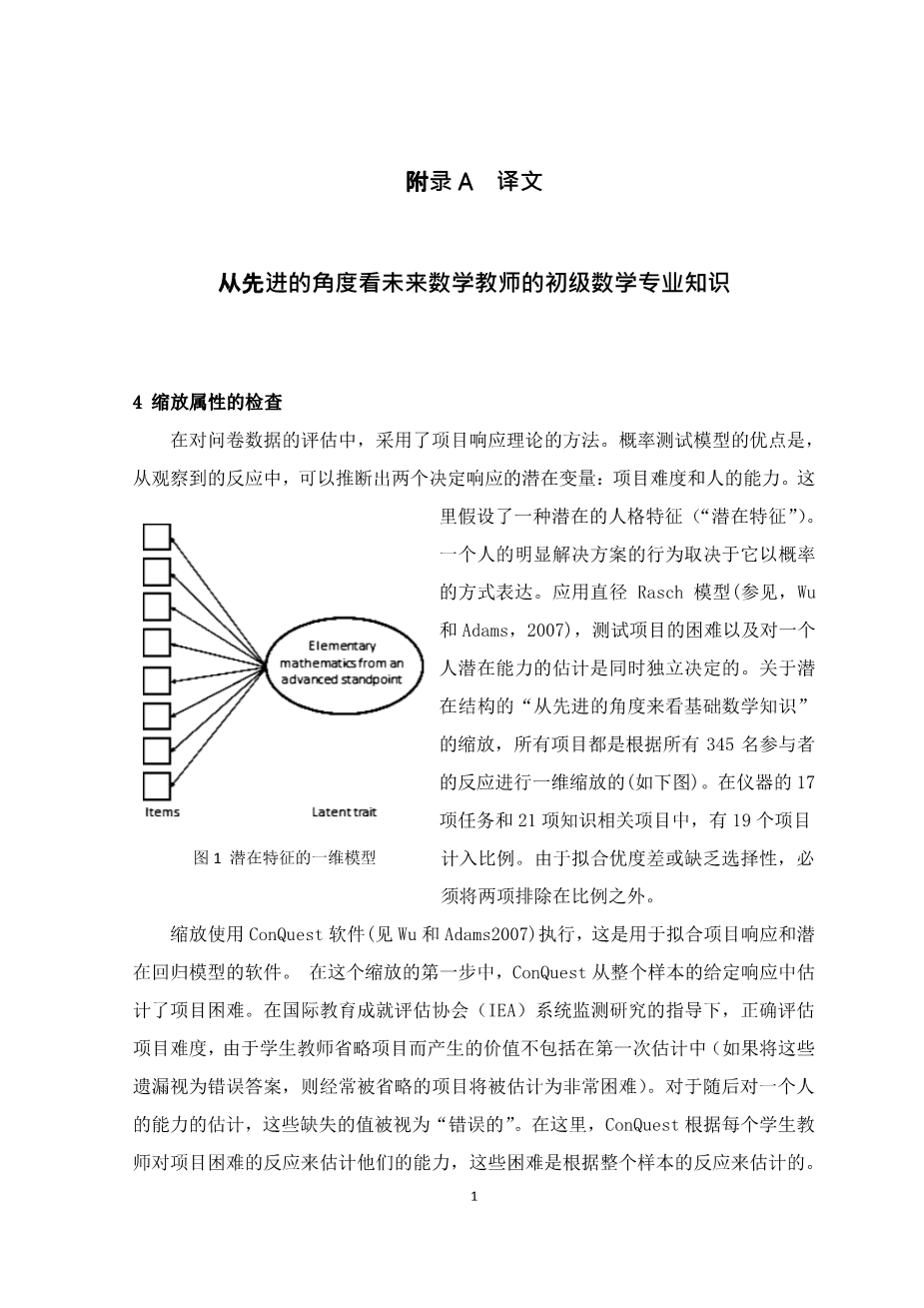4 Examination of scaling properties
In the evaluation of the questionnaire data, methods of Item Response Theory were used. The advantage of probabilistic test models is that from the observed responses, two latent variables can be inferred that determine the responses: the item difficulty and the ability of the person. Here an underlying personality trait (lsquo;lsquo;latent traitrsquo;rsquo;) is presumed. The manifest solution behaviour of a person depends on its expression in a probabilistic manner. Applying a oneparameter Rasch model (cf. Wu and Adams 2007), the difficulties of test items as well as estimates for the latent abilities of a person are determined simultaneously and independently. Concerning the scaling of the latent construct lsquo;lsquo;knowledge in elementary mathematics from an advanced standpointrsquo;rsquo;, all items were scaled unidimensionally and on the basis of the responses from all 345 participants (cf. Fig. 1). Of the 17 tasks of the instrument with a total of 21 knowledge-related items, 19 items were included in the scaling. Two items had to be excluded from the scaling because of poor goodness of fit or a lack of selectivity.
The scaling was executed using the ConQuest software (see Wu and Adams 2007), which is software for fitting item response and latent regression models. In the first step of this scaling ConQuest estimated the item difficulties from the given responses of the whole sample. To estimate the item difficulties correctly—guided by the systemmonitoring studies of the International Association for the Evaluation of Educational Achievement (IEA)—missing values that arise because student teachers omit items were not included in this first estimation (if these omissions were to be treated as wrong answers, items that have often been omitted would be estimated as very difficult). For the subsequent estimation of a personrsquo;s abilities, these missing values were treated as lsquo;lsquo;falsersquo;rsquo;. ConQuest here estimated the ability of each student teacher on the basis of his or her responses with regard to the item difficulties that have been estimated on the basis of the responses of the whole sample. For the estimation and presentation of both item difficulties and individual abilities of the latent trait, weighted likelihood estimates (WLE) (Warm 1989) were applied, which are parameters generated by ConQuest on a logit-scale. The ability parameters can be mapped conveniently within the probabilistic test model on the same scale as the item difficulty. If a personrsquo;s ability corresponds with an item difficulty, then, according to the Rasch model, it can be assumed that the person is able to solve the item correctly with a 50 % probability.
The EAP/PV (Expected A Posteriori/Plausible Values) reliability is an indicator for the measurement erroradjusted test reliability, the parameter in terms of size being comparable to Cronbachrsquo;s alpha in classical test theory. The reliability of the scale of .69 lies barely within the acceptable range. But taking into account the relatively small number of items in the scale, the scope of this exploratory study, and the expected heterogeneity of the construct due to the variety of mathematical areas, this value may in our case be considered as satisfactory. Additional factor analyses here could bring further insight into the scale, in particular whether the initially assumed pragmatic unidimensionality is ensured within the construct or the construct as a whole is more heterogeneous. If that is the case, the reliability of the instrument would probably increase when respective subdimensions are considered; but on the other hand, many more items would be needed to cover the various dimensions of the construct. However, these factor analyses are at present still pending.
In this context it is important that the items are scattered sufficiently widely in terms of their difficulty so that the abilities of the future teachers could be estimated accurately throughout the empirical spectrum. Figure 2 gives an overview of the empirical distribution of the item difficulties. Here the items are represented on the right-hand side of the scale by a number from 1 to 21. Items that are listed several times are partial credit items that are listed once each for their specific stage. On the left-hand side of the scale, the abilities of the observed future teachers are represented by an lsquo;lsquo;xrsquo;rsquo; (an lsquo;lsquo;xrsquo;rsquo; standsfor 2.0 persons). The estimation of the personrsquo;s abilities (WLE) is expressed in logit units, which have a mean of 0. From Fig. 2, we can see that the distribution of item difficulties follows relatively well the variation in the personrsquo;s abilities. So far in the study we find over the entire range of difficulty a reasonably accurate estimation of ability parameters. Based on these estimated abilities (which were transformed to a more easily understandable metric with a mean of 100 and a standard deviation of 20 points—following the usual practice in international comparative studies—with no significant change in the ranking or the relative distances between test persons) group-specific results are reported in the next section.
5 Results
5.1 Comparison of the country-specific subsamples The country-specific subsamples differ in their results concerning the knowledge of elementary mathematics from an advanced standpoint. For the interpretation of the quantitative results, it is important to remark that although the instrument measures a latent ability in knowledge on elementary mathematics from an advanced standpoint, the performance is substantially a result of the processing of only a small section of the entire imaginable spectrum of items to this area and therefore depends on the items that were used in the test.
Table 5 and the boxplots in Fig. 3 give an overview of the country-specific results.
The country as a variable obviously has a significant impact on the results achieved. A
剩余内容已隐藏,支付完成后下载完整资料


英语译文共 25 页,剩余内容已隐藏,支付完成后下载完整资料
资料编号:[405212],资料为PDF文档或Word文档,PDF文档可免费转换为Word


